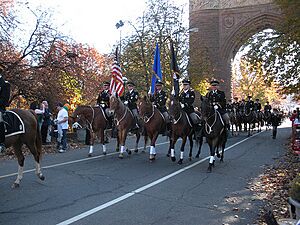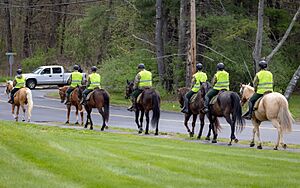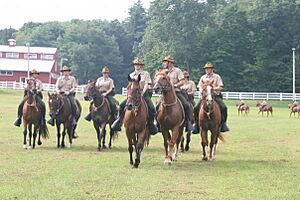Governor's Guards facts for kids
The Governor's Guards in Connecticut are four special groups that are part of the Connecticut State Militia. They are like a state-level military force. There are two "foot guard" groups (who march) and two "horse guard" groups (who ride horses). All members are volunteers. They work under the Connecticut Adjutant General and the Governor of Connecticut, who is their main leader.
Quick facts for kids Connecticut State Guard |
|
|---|---|
| Active | 1771 – Present |
| Country | |
| Allegiance | |
| Branch | |
| Type | Foot Guards, Horse Guards |
| Role | Public Duties |
Contents
History of the Governor's Guards
The four Connecticut Governor's Guards groups started a long time ago, during colonial times. Their job was to protect the Governor when he traveled between New Haven and Hartford. These two cities were both state capitals until 1875. The Guards also escorted important visitors around the state.
- The First Company Governor's Foot Guard began in 1771. A Second Company was added in 1775. The First Company Governor's Foot Guard is the oldest American military group that has been active without stopping.
- The First Company Governor's Horse Guards started in 1778. It is the oldest continuously active mounted cavalry (horse-riding) unit in the United States.
- The Second Company Governor's Horse Guard was formed in 1808 in New Haven.
First Company Governor's Foot Guard
The First Company Governor's Foot Guard was created in Hartford in October 1771. It is the oldest military group in the United States that has been active without a break. Even though other groups might have started earlier, this company has a unique record of continuous service.
In 1771, Hartford was a small town with about 3,000 people. It was quite far from bigger cities like New York or Boston. A trip to those cities took three days by stagecoach.
A group of young men in Hartford decided to create a special company. Their goal was to escort the Governor and the General Assembly during elections. This idea came after a messy escort duty in 1768. Samuel Wyllys and others asked the General Assembly for permission. The Assembly agreed, and Samuel Wyllys became the first Captain. At first, the group was just called the Governor's Guard.
Uniform of the Foot Guard
The ceremonial uniform of the First Company looks much like the original one. It has changed a little over the years. People believe the first uniform was copied from the Coldstream Guards, who protected Queen Charlotte.
The uniform includes a bright red coat with buff-colored tails. It has black velvet trim with silver braid. The vest and pants are buff, and the leggings are black velvet. The hat, called a 'busby,' is made of bear fur. It has the State Coat of Arms on the front and a red and black feather on the side. Enlisted members wear white straps across their chests. Sergeants wear a white belt, a sword, and shoulder scales. Officers wear a black and silver belt, fancy shoulder pads, and carry a saber instead of a sword.
The First Company Governor's Foot Guard has been part of many historical events. In 1777, they decided to join the patriot army at Saratoga. They were on their way when they heard that the British General Burgoyne had surrendered.
Second Company Governor's Foot Guard
Soon, people in New Haven, Connecticut's other capital, wanted their own Governor's Guards unit. The Second Company was formed in New Haven. Benedict Arnold helped organize it and was elected its first captain. This led the original unit to be called the First Company Governor's Guard.
Later, in 1778, when a Horse Guards unit was formed, the original unit became the "First Company Governor's Foot Guard." The New Haven unit became the "Second Company Governor's Foot Guard." Both Foot Guard units are recognized as separate groups by Connecticut.
Role in the American Revolution
At the start of the American War of Independence, members of the Second Company wanted to go to Massachusetts. Fighting had already begun there at Lexington and Concord. The colonial leaders wanted the Guards to stay home and kept their weapons locked up.
On April 22, 1775, Captain Benedict Arnold gathered his men. He demanded the keys to the weapons storage. He said they would break in if they didn't get them. He famously stated, "None but the Almighty God shall prevent my marching." This event is remembered on Powder House Day.
During the American Civil War, men from the Second Company formed Company "K" of the 6th Connecticut Volunteers. They fought in 26 battles during the war. The New Haven Armory was the home of the Second Company from about 1930 until 2010.
First Company Governor's Horse Guards
Early Horse Guards: 1658-1777
Having mounted troopers to escort important people has been a tradition in Connecticut since 1658. The first cavalry "horse guard" group had 37 men and horses from Hartford and nearby towns. They were led by Major John Mason, the colony's military chief. Their uniforms looked like the "Oxford Blues" of England's Royal Regiment of Horse Guards. Their shoulder patch was a winged thunderbolt.
Reorganization and Escorts: 1778-1840
Captain Thomas Y. Seymour, a former officer, organized the Horse Guards again in 1778. Many members were private citizens and veterans of the American Revolutionary War. Within ten years, the group grew large enough to ask the governor to become an official "troop of volunteer Horse." This request was approved on May 19, 1788. It was then called the "Governor's Independent, volunteer Troop of Horse Guards."
The Horse Guards escorted many important people. These included Connecticut's Governors and others like George Washington in 1789, President John Adams in 1798, President James Monroe in 1817, and General The Marquis de Lafayette in 1824. They also escorted President Andrew Jackson.
During this time, their uniform was a "bear skin dragoon hat." They wore a white coat with gold lace and braid, a red belt, tight pants, and boots with yellow tops.
Challenges and Revival: 1840-1911
The troop was not very active during the 1840s. They did not escort anyone or take part in drills or parades. To bring the troop back, some Hartford citizens started a new Horse Guard. They used the 1788 charter. Samuel Colt, the inventor of the Colt revolver, was elected as their leader.
However, the original Horse Guards were still active, led by Major Henry Boardman. When both groups asked to be recognized as the "true" First Company, the Governor chose Boardman's Horse Guards. Colt had to lead his group under a new name. After this confusion, Boardman quickly restarted the troop's activities, escorting presidents and governors.
At this time, the troop's uniform included a "bear-skin cap with a rosette and gilt eagle." They wore a dark blue coat with brass buttons. Their trousers were sky blue with straps under the instep, all trimmed with orange piping.
Modernization and War Service: 1911-1919
The Connecticut General Assembly passed a law allowing both Horse Guards units to become cavalry in the Connecticut National Guard. The First Company took some time to agree. It eventually reorganized as Troop B Cavalry, C.N.G. This happened after the Second Company Governor's Horse Guards had already reorganized as Troop A Cavalry. Troop B then began intense training to meet federal cavalry standards.
In 1911, Troop B raised money for a new armory (a place for training and stables). It was built between 1912 and 1913 in West Hartford. Today, it is still standing and used as an office building called 'The Armory.'
On June 18, 1916, President Woodrow Wilson called up National Guard troops. This was in response to an attack by Pancho Villa in New Mexico. Troop B was sent to the Mexican border in Nogales and Arivaca, Arizona. They stayed there for several months guarding the border.
On April 6, 1917, less than six months after returning from Arizona, President Wilson declared war on Germany. Troop B was split into two groups, B and L. They were ordered to get more members for the war. Troops B and L were called into federal service on August 5, 1917. They became the 101st Machine Gun Battalion, 26th Division. They served in France in several battles before returning to America in April 1919.
After World War I, in 1919, the unit was reorganized as Troop B of the 122nd Cavalry, Connecticut National Guard.
World War II and Beyond: 1940-Present
In May 1940, Troops B and A became part of the 1st Battalion of the 208th Coast Artillery Anti-Aircraft (AAA). This unit was called to active duty three days after Pearl Harbor. It became the 745th Antiaircraft Artillery Gun Battalion. The 745th was stationed in Townsville, Queensland, Australia.
Back in Connecticut, the Troop trained a "Home Guard." This group had two troops that stayed active during World War II in Avon.
In 1946, Troop B C.N.G. stopped being a National Guard Unit. The First Company Governor's Horse Guards once again became part of the Organized Militia of Connecticut. It became a "self-sustaining unit" in its military work.
In 1955, the First Company moved to its current location in Avon, Connecticut. This property has over 37 acres of riding trails, a drill field, a stable for 50 horses, and two outdoor riding rings. It still uses the same Charter from 1788.
Current Activities and Training
The Troop performs various ceremonial duties. These include parading, providing people and horses for dedication ceremonies, escorting important visitors, and attending inaugural celebrations for the Governor and sometimes the President. The First Company Governor's Horse Guards drills every Thursday evening. During this time, the riding platoon practices mounted drill formations and riding skills.
Training for new members happens once or twice a year and lasts 16 weeks. Recruits learn military posture, drill and ceremony, horsemanship, horse care, and cavalry traditions. Volunteers must be between 18 and 60 years old and a United States citizen. No past military or horse experience is needed.
Horses of the Horse Guards
The horses of the First Company Governor's Horse Guards are male horses (geldings). They are healthy and have good temperaments. They are usually brown, chestnut, or bay in color and are between 15 and 16 hands tall (a unit of measurement for horses). They are often given to the troop by private owners or bought with troop funds. Once donated or bought, they become property of the Connecticut Military Department. The breeds vary and include Quarter Horses, Standardbreds, and Thoroughbreds.
Second Company Governor's Horse Guard
The Second Company Governor's Horse Guard was officially started in 1808. It was the horse guard unit for the New Haven area. It is located in Newtown, Connecticut. This unit performs ceremonial and community duties. It has also developed a program that uses horses to help people with special needs.
The Governor's Guards Today
All four units of the Governor's Guards are still active today. They are part of the Connecticut Military Department. Their main job is ceremonial, meaning they participate in parades and special events. However, they can also be called to active service to help the Connecticut National Guard during state emergencies.
They do their annual training every August at Camp Nett in East Lyme. Over the years, their headquarters have moved due to space and cost. Currently, their headquarters are:
- First Company Governor's Foot Guard - Hartford
- Second Company Governor's Foot Guard - Branford
- First Company Governor's Horse Guard - Avon
- Second Company Governor's Horse Guard - Newtown
Helping During the COVID-19 Pandemic
In March and April 2020, members of the Foot and Horse Guards were called to help. They assisted the Army and Air National Guard and the Connecticut Department of Public Health. Their task was to set up and prepare the Mobile Field Hospital during the COVID-19 pandemic. The units regularly train to assemble and take down these mobile hospitals at Camp Hartell in Windsor Locks.
See also
- Connecticut Wing Civil Air Patrol
- National Lancers
- Naval militia
- United States Coast Guard Auxiliary





